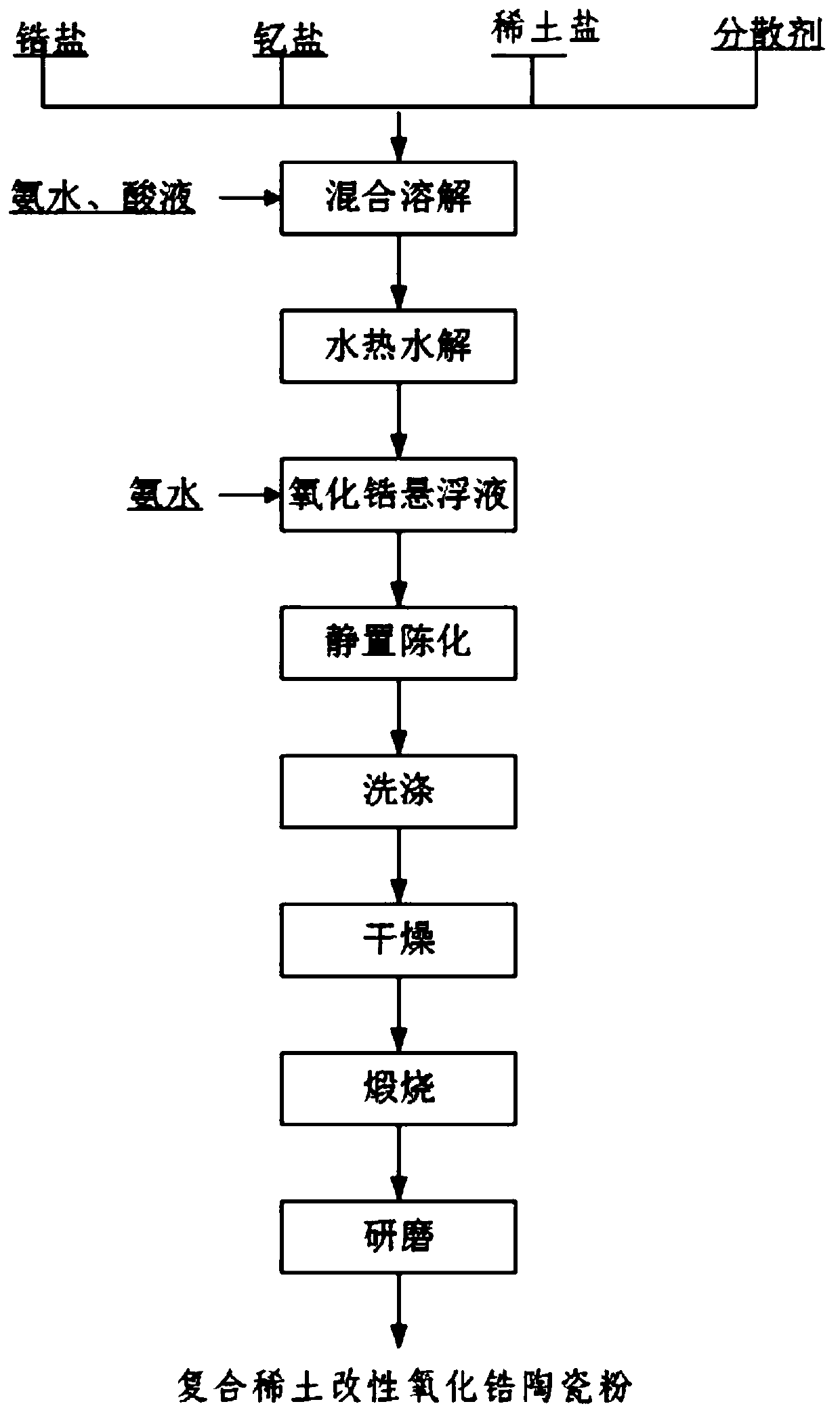Composite rare earth modified zirconia ceramic powder and preparation method thereof
A technology of zirconia ceramics and composite rare earth, which is applied in the field of composite rare earth modified zirconia ceramic powder and its preparation, and can solve the problems of difficult treatment and high consumption of organic waste water.
- Summary
- Abstract
- Description
- Claims
- Application Information
AI Technical Summary
Problems solved by technology
Method used
Image
Examples
preparation example Construction
[0040] A method for preparing rare earth-modified zirconia composite powder by means of hydrothermal hydrolysis and surface induction coating rare earth, the preparation method comprising the following steps:
[0041] (1) Reaction solution preparation method: prepare zirconium oxychloride, rare earth salt, dispersant raw material solution, its Zr 4+ Concentration 0.1~2.5mol / L, Zr 4+ with Y 3+ The molar concentration ratio is 99:2~90:20, Zr 4+ The ratio of molar concentration to other rare earth elements is 99:1~92:8, and the concentration of dispersant is 0.5~5g / L; the raw material solution is placed in a reaction kettle, and the temperature is 25~90℃, and the high speed stirring is 300~1000r / min. Next, through an atomizer, add a solution of 0.5-6 mol / L ammonia solution or a 0.1-3 mol / L hydrochloric acid solution at a rate of 1-10000 mL / min to adjust the raw material solution H + Concentration, so that Zr in the solution 4+ Partial hydrolysis to generate crystal nuclei, ad...
Embodiment 1
[0047] (1) Preparation of ZrOCl 2 , YCl 3 , Ce(NO 3 ) 3 , mixed solution of hydroxypropyl cellulose, wherein Zr 4+ :Y 3+ : Ce 3+ The molar ratio is 95.05:1.45:3.5, the raw material solution is placed in the reaction kettle, and the H of the final reaction solution is adjusted by adding 5.95mol / L dilute ammonia solution in a 60°C water bath and stirring at 500r / min. + concentration, so that the solution final C Zr 4+ =1.6mol / L, H + The concentration is 1.5mol / L, the concentration of hydroxypropyl cellulose is 0.5g / L, and the hydrothermal reaction solution is obtained;
[0048] (2) Transfer the solution obtained in step (1) to a polytetrafluoroethylene-lined stainless steel reactor, heat to 180°C for hydrothermal hydrolysis, react for 12 hours and then cool to obtain a hydrated zirconia suspension;
[0049] (3) Add 10% ammonia water to the hydrated zirconia suspension at 60°C and 500r / min at 10mL / min to make Y 3+ / C 3 + Uniformly precipitate on the surface of hydrate...
Embodiment 2
[0052] (1) Preparation of ZrOCl 2 , YCl 3 , Ce(NO 3 ) 3 , mixed solution of hydroxypropyl cellulose, wherein Zr 4+ :Y 3+ : Ce 3+ The molar ratio is 94.57:1.93:3.5, the raw material solution is placed in a reaction kettle, and the H of the final reaction solution is adjusted by adding 5.95mol / L dilute ammonia solution in a 60°C water bath and stirring at 500r / min. + concentration, so that the solution final C Zr 4+ =1.6mol / L, H + The concentration is 1.2mol / L, and the concentration of hydroxypropyl cellulose is 0.5g / L to obtain the hydrothermal reaction solution;
[0053] (2) Transfer the solution obtained in step (1) to a polytetrafluoroethylene-lined stainless steel reactor, heat to 160°C for hydrothermal hydrolysis, and cool after reacting for 12 hours to obtain a hydrated zirconia suspension;
[0054] (3) Put the suspension at 60°C and 500r / min, add 10% ammonia water at 10mL / min to make Y 3+ / C 3+ Uniformly precipitate on the surface of hydrated zirconia particle...
PUM
 Login to View More
Login to View More Abstract
Description
Claims
Application Information
 Login to View More
Login to View More - R&D
- Intellectual Property
- Life Sciences
- Materials
- Tech Scout
- Unparalleled Data Quality
- Higher Quality Content
- 60% Fewer Hallucinations
Browse by: Latest US Patents, China's latest patents, Technical Efficacy Thesaurus, Application Domain, Technology Topic, Popular Technical Reports.
© 2025 PatSnap. All rights reserved.Legal|Privacy policy|Modern Slavery Act Transparency Statement|Sitemap|About US| Contact US: help@patsnap.com



